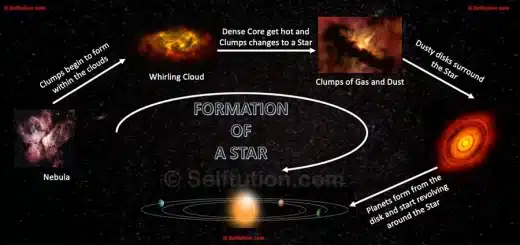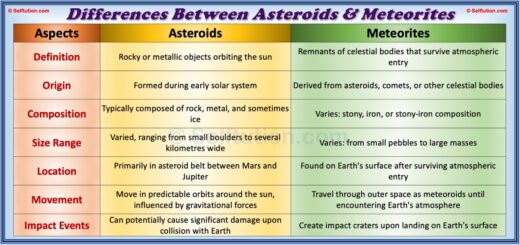Facts about Stars for Kids – Definition, Formation and Lives
Here are some cool facts about stars for kids discussed in this post: the definition of a star, how many stars there are in the universe, how stars are formed, why they twinkle, and more. But before we proceed, please read this:
Twinkle, twinkle, little star, how I wonder what you are. Up above the world so high, like a diamond in the sky.
This is the rhyme that most of us recited during our childhood. The rhyme brings out the curiosity in kids to learn more about stars. Since prehistoric times, mankind has been mesmerized by the beauty of the night sky and the stars it holds. On any clear night, we can see thousands of twinkling dots with the naked eye. Not all of these shining dots are stars, but most are. Besides stars, the universe contains many other fascinating objects like planets, comets, nebulae, supernovas, meteoroids, asteroids, pulsars, magnetars, and black holes. However, in this post for kids, we will focus on stars and share some interesting facts and answers to frequently asked questions (FAQs) about them.
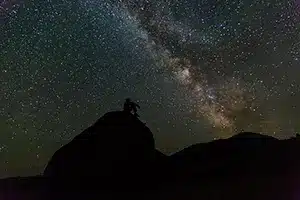
Facts about Stars Covered for Kids
- What are the stars, or what is the definition of a star?
- How many stars are there in the Universe?
- What are stars made of?
- How star is formed?
- The lives and deaths of stars
- Why do stars twinkle?
- The color of stars, what it tells?
- The nearest star to the Earth other than the Sun
- Pole star
- Evening Star
WHAT ARE THE STARS?
A simple definition of a star for kids –
A star is a huge fiery ball of gas, mostly hydrogen like our Sun.
Is the Sun considered a star, and how much larger when compared to the Earth? Yes, our Sun is also a star, and it is 109 times bigger than the Earth.
There are countless billions of stars in the universe. All other stars, except our Sun, appear as tiny dots in the sky because they are very far away from us. The nearest star to Earth, other than the Sun, is Proxima Centauri. It is approximately 4.22 light-years away from Earth. This means that if you could travel at the speed of light, which is 299,792,458 meters per second, it would take you 4.22 years to reach Proxima Centauri.
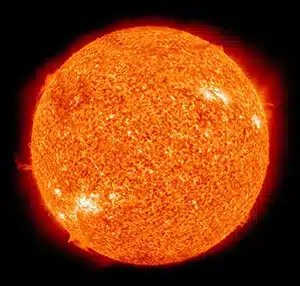
The Sun – The nearest star to the Earth
Although our Sun is much larger than the Earth, it is relatively small for a star. Some stars are 100 to 500 times larger! In addition to these giant and supergiant stars, there are other fascinating types of stars. White dwarf stars, remnants of medium-sized stars, can be as small as the Earth. Neutron stars, the remnants of massive stars that have exploded in supernovas, are incredibly dense and only about 20 kilometers in diameter. Pulsars, which are rotating neutron stars, emit beams of radiation. Magnetars, another type of neutron star, have powerful magnetic fields. These diverse and intriguing types of stars show just how varied and amazing our universe is.
If you think the post is over, you are wrong; there are some more interesting facts about stars for kids. Next, how many stars are there in the Universe?
HOW MANY STARS ARE THERE IN THE UNIVERSE?
How many stars are there in the universe? This is one of the most difficult questions to answer because the technology to count all the stars in the universe doesn’t exist. However, astronomers can make estimates based on our current observations. According to their calculations, there are about 100 billion stars in our galaxy, the Milky Way. Additionally, there are approximately 10 billion galaxies in the observable universe.
By multiplying these numbers, we get an estimated total of 1 x 10²¹ stars, or 1,000,000,000,000,000,000,000 stars in the observable universe. To give you an idea of how vast this number is, it’s like trying to count every grain of sand on all the beaches on Earth.
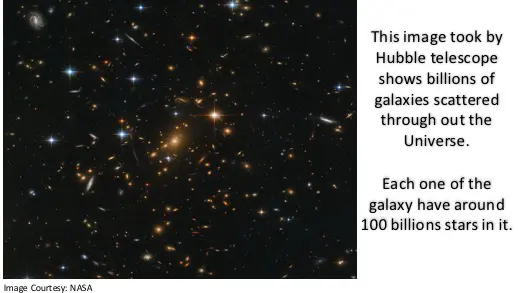
It’s important to note that this estimate only includes the observable universe. The actual universe could be much larger, with even more stars that we cannot see or detect with current technology. The number of stars also changes as new stars are born and old stars die. So, while 1 x 10²¹ is our best estimate, the true number of stars in the universe might be far beyond our comprehension.
If you think this was the last one, you are again wrong; there are more facts about stars for kids waiting for you. Next, what are stars made of?
WHAT ARE STARS MADE OF?
Stars are fascinating celestial objects composed mainly of scorching, burning gases, primarily hydrogen and helium. Their immense size and mass create immense pressure at their cores. Nuclear fusion is the process in which two small atoms like hydrogen fuse together to make a bigger atom. During nuclear fusion, a huge amount of energy is released in the form of heat. This pressure triggers nuclear fusion a process where lighter elements like hydrogen fuse together to form heavier elements like helium, releasing a tremendous amount of energy.
The core of a star acts like a colossal nuclear power plant, where hydrogen atoms fuse to form helium atoms through nuclear fusion. This process generates an enormous amount of heat and energy, causing the core temperature to soar to approximately 15,000,000ºC (27 millionºF).
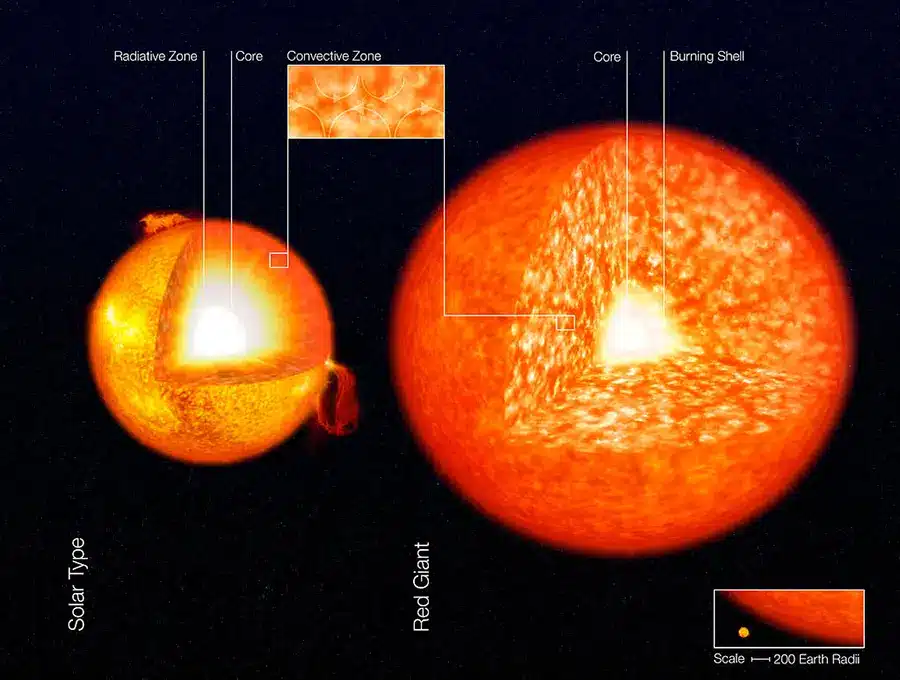
The Core of the Sun and a Red Giant Star
As this intense heat radiates outward, it creates the blazing inferno that characterizes the surface of stars. Surface temperatures can vary widely, ranging from 3,500°C (6,300°F) for cooler stars to a scorching 45,000°C (25,000°F) for the hottest ones. These temperatures are so extreme that they can melt almost any substance. A star is not a place you would like to go.
In summary, stars are primarily made of hydrogen and helium gases, and their incredible heat and pressure at their cores fuel the nuclear fusion process, which powers their luminosity and sustains their fiery existence.
The post is still not over. There are some more amazing facts about stars for kids. Next, how are stars formed?
HOW STARS ARE FORMED?
Stars are formed through a fascinating process that begins inside a nebula, a vast interstellar cloud of dust, hydrogen, and other gases. Approximately 4.6 billion years ago, within these nebulae, gravity started to pull gas and dust together, forming clumps. As these clumps grow, their gravitational pull increases, causing smaller clumps to orbit around them.
As the central clump becomes denser and more compact, it heats up. When its temperature reaches about 10 million°C, a critical threshold is crossed, and nuclear fusion ignites within the clump. This fusion process transforms the clump into a glowing star.

Facts about stars for kids -How stars are formed? The complete cycle of star formation.
In a medium-sized star, the heat generated by nuclear fusion tries to expand the star outward. However, gravity counteracts this expansion by pulling the star inward. This delicate balance between the outward pressure of heat and the inward pull of gravity allows the star to maintain its size and glow steadily for billions of years.
In summary, stars are formed from the gravitational collapse of gas and dust within a nebula, initiating the process of nuclear fusion that sustains their luminous existence.
If you think it was the last one, you are wrong, there are some more interesting facts about stars for kids. Next, the lives and deaths of stars.
THE LIVES AND DEATHS OF STARS
The lives and deaths of stars are captivating cosmic dramas that unfold across the universe. Stars are born and eventually meet their demise, each stage revealing different facets of their existence.
Observing various types of stars allows us to glimpse stars at different stages in their lives. Large stars, for instance, typically blaze brilliantly but briefly, burning ferociously for no more than ten million years before collapsing into black holes. Medium-sized stars, such as our Sun, have longer lifespans, lasting about ten billion years before reaching their dramatic conclusions, either exploding in a supernova or dwindling into a white dwarf.
For most of their lives, stars maintain a stable size, sustained by nuclear reactions at their cores, where hydrogen is converted into helium. However, as stars enter the final 10% of their existence, they embark on a series of transformative sequences leading to their demise.
In the first stage of this process, a star exhausts its hydrogen fuel at its core and begins fusing helium to form heavier elements. What happens next in the second stage of a star’s demise is determined by its mass.
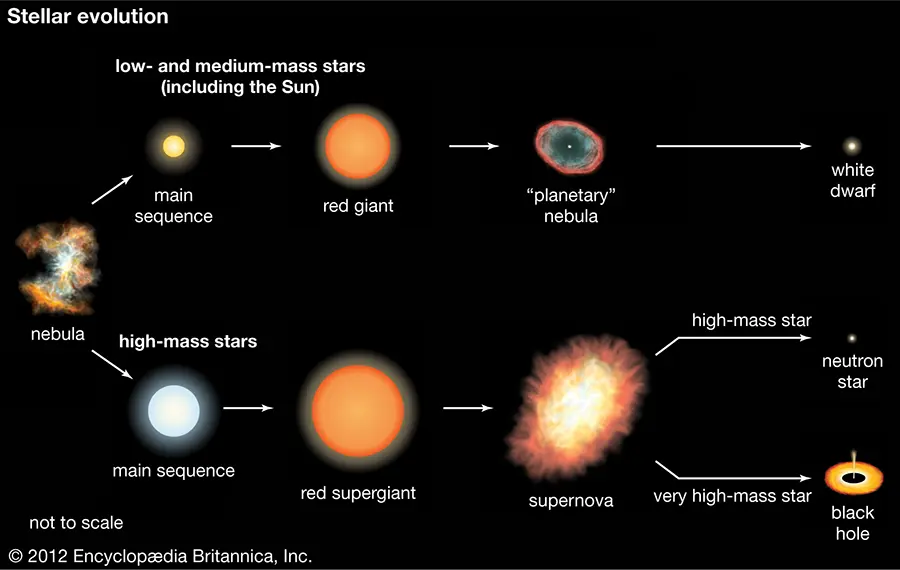
Facts about stars for kids -Lives and Deaths of Stars
Death of a star with a mass more than 20 times that of our Sun
When a star’s mass exceeds 20 times that of our Sun, its demise is marked by a spectacular series of events. As the star exhausts its nuclear fuel, its outer layers cool and expand, transforming it into a red giant. Despite this expansion, helium fusion persists, generating heavier elements within the core. However, once iron (Fe) forms in the core, the star’s energy dynamics shift drastically, causing it to collapse rapidly. This collapse triggers a monumental explosion known as a supernova, shining with the radiance of millions of Suns for a few weeks. During this cataclysmic event, the star’s outer layers are blown off, leaving behind a dense core. This remnant often takes the form of a black hole, a cosmic entity with gravity so intense that not even light can escape its grasp.
Death of a star with a mass between 8 to 20 times that of our Sun
A pulsar is a highly magnetized, rotating neutron star. Magnetars are a type of neutron star, like pulsars, but with a powerful magnetic field.In a star with a mass between 8 to 20 times our Sun, the supernova blows off all the star’s layers, except the iron core. The intense gravity of this core compresses it further. Under such extreme pressure, protons and electrons within the core merge to form neutrons. This process forms a compact object known as a neutron star, with a diameter of approximately 20 kilometers. Despite its small size, a neutron star can possess a mass ranging from 1.5 to 5 times that of our Sun. Neutron stars are incredibly dense, harboring gravitational fields so strong that they challenge the limits of our understanding of physics.
Death of a star with a mass less than 8 times othat f our Sun
When a star’s mass is less than 8 times that of our Sun, its demise follows a different path. Rather than culminating in a spectacular supernova explosion, these smaller stars evolve into white dwarfs. As these stars age, they exhaust the hydrogen in their core and begin fusing helium into heavier elements. This fusion process causes them to shed their outer layers over approximately 50,000 years. Once this shedding is complete, all that remains is the star’s core, giving rise to a white dwarf. Over time, the white dwarf gradually cools and releases energy from its outer layer, eventually fading into an invisible state known as a black dwarf.
Despite its diminished luminosity, the mass of a white dwarf remains significant, typically around 1.45 times that of its progenitor star. Thus, stars with masses less than 8 times that of our Sun conclude their lives as white dwarfs, including our own Sun.
There are some more interesting facts about stars for kids. Next, why do stars twinkle?
WHY STARS, TWINKLE?
When observing stars from Earth, they often appear to twinkle in the night sky. This twinkling effect occurs because the light from the stars must pass through Earth’s atmosphere, which contains moving bands of hot and cold air. As the light traverses these dynamic atmospheric layers, it is refracted or bent, causing fluctuations in its intensity and direction. This atmospheric turbulence leads to the perceived twinkling of stars, as the light appears to flicker and shimmer.
However, in the vacuum of space, stars do not twinkle. Without the interference of Earth’s atmosphere, the light from stars travels undisturbed, maintaining a steady and constant brightness. Thus, while stars may seem to twinkle when viewed from Earth due to atmospheric effects, their brilliance remains unwavering in the vastness of space.
Next, some interesting facts about the colors of stars for kids.
THE COLOR OF STARS AND WHAT IT TELLS?
The color of stars provides valuable insights into their temperature and brightness, despite their immense distance from us.
Whiter and hotter stars emit a brighter glow, indicating high surface temperatures. These stars typically appear bluish-white and can reach surface temperatures exceeding 25,000ºC (45,000ºF). Their intense heat generates significant energy, resulting in their luminous brilliance.
Conversely, redder and cooler stars emit a dimmer glow, signaling lower surface temperatures. Stars with a reddish hue are cooler, with surface temperatures typically below 6,000ºC (10,000ºF) for yellowish stars and under 3,500ºC (6,300ºF) for orange-red stars. These cooler temperatures result in a softer, less intense luminosity.
THE NEAREST STAR TO THE EARTH, OTHER THAN THE SUN
The nearest star to Earth, other than the Sun, is Proxima Centauri. Located at a distance of 4.22 light-years (approximately 3.99 x 10¹³ kilometers) away, Proxima Centauri is part of a trio of stars known as Alpha Centauri, held together by gravitational forces. The other two stars in this group are Alpha Centauri A and Alpha Centauri B. Proxima Centauri stands out as a red dwarf star, characterized by its smaller size, with a diameter only one-seventh that of our Sun. Despite its proximity, Proxima Centauri remains a distant neighbor in the vastness of space.
POLE STAR
The Pole Star, also known as the North Star, holds a special place in the night sky as the brightest star visible to the naked eye. Positioned directly above the North Pole, it is a reliable navigational aid. Unlike other stars whose positions shift with the Earth’s rotation, the Pole Star remains relatively fixed in the night sky due to its unique location in space.
This steadfastness makes the Pole Star a valuable reference point for determining direction, particularly during nighttime navigation. By locating the Pole Star and observing its position relative to the horizon, travelers can discern true north, aiding in orientation and navigation across land and sea.
Throughout history, the Pole Star has played a crucial role in guiding explorers, sailors, and travelers alike, serving as a constant beacon in the ever-changing expanse of the celestial sphere.
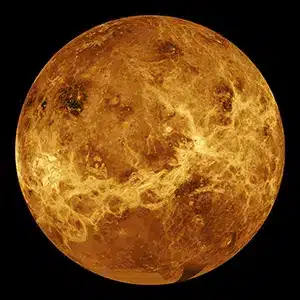
The planet Venus
EVENING STAR
The Evening Star refers to the planet Venus when it appears as the brightest object in the sky after the Sun. Venus, often referred to as an evening star, is visible for a few hours before sunset. This phenomenon occurs because Venus orbits closer to the Sun than Earth, resulting in its position relative to the Sun and Earth’s observer changing throughout the year.
Despite its planetary status, Venus is commonly mistaken for a star due to its luminous appearance. Alongside other planets like Jupiter, Saturn, and Mars, Venus shines brightly in the night sky by reflecting the sunlight it receives. This reflection of sunlight allows these planets to be visible to the naked eye, leading to their frequent misidentification as stars.
As one of the brightest celestial objects visible from Earth, Venus captivates observers with its brilliant presence, earning it the title of the Evening Star when it graces the sky in the hours preceding sunset.


